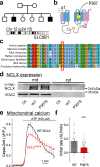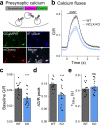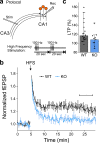Aberrant activity of mitochondrial NCLX is linked to impaired synaptic transmission and is associated with mental retardation
- PMID: 34079053
- PMCID: PMC8172942
- DOI: 10.1038/s42003-021-02114-0
Aberrant activity of mitochondrial NCLX is linked to impaired synaptic transmission and is associated with mental retardation
Erratum in
-
Author Correction: Aberrant activity of mitochondrial NCLX is linked to impaired synaptic transmission and is associated with mental retardation.Commun Biol. 2021 Jun 14;4(1):755. doi: 10.1038/s42003-021-02312-w. Commun Biol. 2021. PMID: 34127779 Free PMC article. No abstract available.
Abstract
Calcium dynamics control synaptic transmission. Calcium triggers synaptic vesicle fusion, determines release probability, modulates vesicle recycling, participates in long-term plasticity and regulates cellular metabolism. Mitochondria, the main source of cellular energy, serve as calcium signaling hubs. Mitochondrial calcium transients are primarily determined by the balance between calcium influx, mediated by the mitochondrial calcium uniporter (MCU), and calcium efflux through the sodium/lithium/calcium exchanger (NCLX). We identified a human recessive missense SLC8B1 variant that impairs NCLX activity and is associated with severe mental retardation. On this basis, we examined the effect of deleting NCLX in mice on mitochondrial and synaptic calcium homeostasis, synaptic activity, and plasticity. Neuronal mitochondria exhibited basal calcium overload, membrane depolarization, and a reduction in the amplitude and rate of calcium influx and efflux. We observed smaller cytoplasmic calcium transients in the presynaptic terminals of NCLX-KO neurons, leading to a lower probability of release and weaker transmission. In agreement, synaptic facilitation in NCLX-KO hippocampal slices was enhanced. Importantly, deletion of NCLX abolished long term potentiation of Schaffer collateral synapses. Our results show that NCLX controls presynaptic calcium transients that are crucial for defining synaptic strength as well as short- and long-term plasticity, key elements of learning and memory processes.
Conflict of interest statement
The authors declare no competing interests.
Figures






Similar articles
-
TMEM65 regulates and is required for NCLX-dependent mitochondrial calcium efflux.Nat Metab. 2025 Apr;7(4):714-729. doi: 10.1038/s42255-025-01250-9. Epub 2025 Apr 8. Nat Metab. 2025. PMID: 40200126 Free PMC article.
-
Functional properties and mode of regulation of the mitochondrial Na+/Ca2+ exchanger, NCLX.Semin Cell Dev Biol. 2019 Oct;94:59-65. doi: 10.1016/j.semcdb.2019.01.009. Epub 2019 Jan 30. Semin Cell Dev Biol. 2019. PMID: 30658153 Review.
-
NCLX protein, but not LETM1, mediates mitochondrial Ca2+ extrusion, thereby limiting Ca2+-induced NAD(P)H production and modulating matrix redox state.J Biol Chem. 2014 Jul 18;289(29):20377-85. doi: 10.1074/jbc.M113.540898. Epub 2014 Jun 4. J Biol Chem. 2014. PMID: 24898248 Free PMC article.
-
Privileged crosstalk between TRPV1 channels and mitochondrial calcium shuttling machinery controls nociception.Biochim Biophys Acta. 2016 Dec;1863(12):2868-2880. doi: 10.1016/j.bbamcr.2016.09.009. Epub 2016 Sep 11. Biochim Biophys Acta. 2016. PMID: 27627464
-
Physiological and Pathophysiological Roles of Mitochondrial Na+-Ca2+ Exchanger, NCLX, in Hearts.Biomolecules. 2021 Dec 14;11(12):1876. doi: 10.3390/biom11121876. Biomolecules. 2021. PMID: 34944520 Free PMC article. Review.
Cited by
-
Mitochondrial calcium cycling in neuronal function and neurodegeneration.Front Cell Dev Biol. 2023 Jan 24;11:1094356. doi: 10.3389/fcell.2023.1094356. eCollection 2023. Front Cell Dev Biol. 2023. PMID: 36760367 Free PMC article. Review.
-
Mitochondria and Oxidative Stress as a Link between Alzheimer's Disease and Diabetes Mellitus.Int J Mol Sci. 2023 Sep 22;24(19):14450. doi: 10.3390/ijms241914450. Int J Mol Sci. 2023. PMID: 37833898 Free PMC article. Review.
-
TMEM65 regulates and is required for NCLX-dependent mitochondrial calcium efflux.Nat Metab. 2025 Apr;7(4):714-729. doi: 10.1038/s42255-025-01250-9. Epub 2025 Apr 8. Nat Metab. 2025. PMID: 40200126 Free PMC article.
-
CKII Control of Axonal Plasticity Is Mediated by Mitochondrial Ca2+ via Mitochondrial NCLX.Cells. 2022 Dec 9;11(24):3990. doi: 10.3390/cells11243990. Cells. 2022. PMID: 36552754 Free PMC article.
-
Synthetic and Natural Bioactive Molecules in Balancing the Crosstalk among Common Signaling Pathways in Alzheimer's Disease: Understanding the Neurotoxic Mechanisms for Therapeutic Intervention.ACS Omega. 2023 Oct 20;8(43):39964-39983. doi: 10.1021/acsomega.3c05662. eCollection 2023 Oct 31. ACS Omega. 2023. PMID: 37929080 Free PMC article. Review.
References
Publication types
MeSH terms
Substances
LinkOut - more resources
Full Text Sources
Molecular Biology Databases
Research Materials

